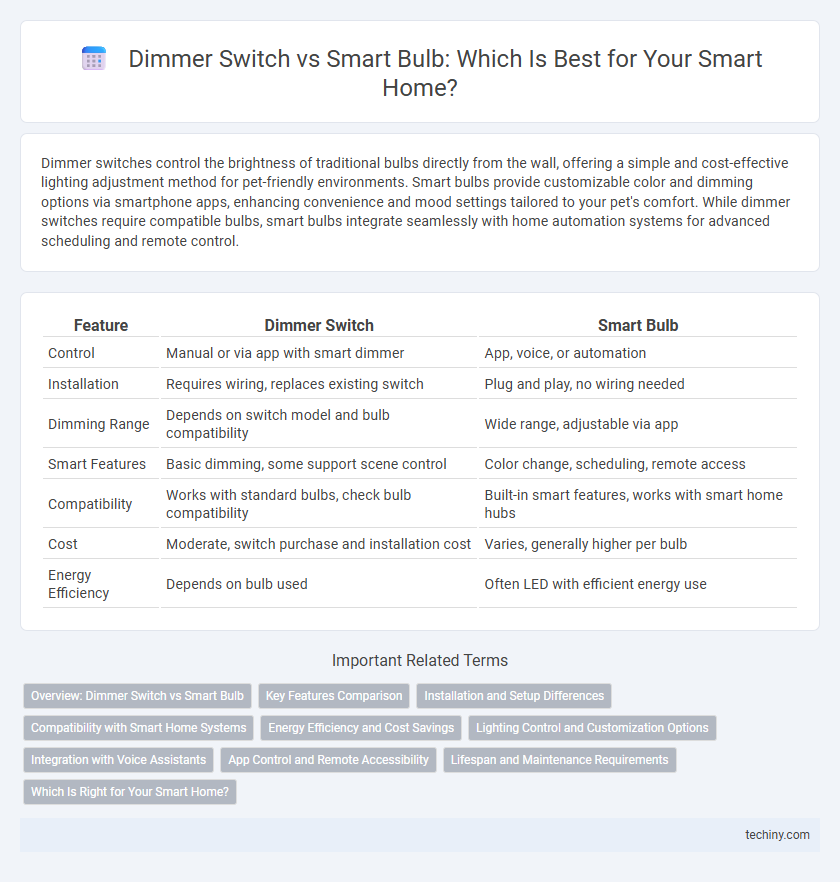Dimmer switches control the brightness of traditional bulbs directly from the wall, offering a simple and cost-effective lighting adjustment method for pet-friendly environments. Smart bulbs provide customizable color and dimming options via smartphone apps, enhancing convenience and mood settings tailored to your pet's comfort. While dimmer switches require compatible bulbs, smart bulbs integrate seamlessly with home automation systems for advanced scheduling and remote control.
Table of Comparison
| Feature | Dimmer Switch | Smart Bulb |
|---|---|---|
| Control | Manual or via app with smart dimmer | App, voice, or automation |
| Installation | Requires wiring, replaces existing switch | Plug and play, no wiring needed |
| Dimming Range | Depends on switch model and bulb compatibility | Wide range, adjustable via app |
| Smart Features | Basic dimming, some support scene control | Color change, scheduling, remote access |
| Compatibility | Works with standard bulbs, check bulb compatibility | Built-in smart features, works with smart home hubs |
| Cost | Moderate, switch purchase and installation cost | Varies, generally higher per bulb |
| Energy Efficiency | Depends on bulb used | Often LED with efficient energy use |
Overview: Dimmer Switch vs Smart Bulb
Dimmer switches control the voltage supplied to traditional bulbs, allowing adjustable brightness without replacing existing fixtures, while smart bulbs integrate wireless connectivity and app control for customizable lighting scenes and remote operation. Smart bulbs offer advanced features like color changing and scheduling, but require compatible hubs or apps, whereas dimmer switches provide seamless integration with most standard lighting systems and physical wall controls. Choosing between a dimmer switch and a smart bulb depends on installation preferences, desired functionality, and compatibility with current home automation setups.
Key Features Comparison
Dimmer switches provide precise control over existing lighting fixtures by adjusting electrical flow, supporting traditional and smart bulbs without replacing hardware. Smart bulbs offer customizable color, brightness, and scheduling via apps or voice assistants, integrating seamlessly into home automation systems. While dimmer switches excel in compatibility and retrofit ease, smart bulbs deliver advanced features like scene setting and energy monitoring for more personalized lighting experiences.
Installation and Setup Differences
Dimmer switches require wiring into the home's electrical system, often needing a compatible fixture and sometimes professional installation, while smart bulbs simply screw into existing sockets and connect wirelessly via apps or hubs. Smart bulbs offer individual control and customization without changing existing wiring, making setup faster and more flexible. Dimmer switches provide centralized control over multiple lights but involve more complex installation and potential compatibility issues with certain bulb types.
Compatibility with Smart Home Systems
Dimmer switches often require compatibility with specific smart home platforms such as Zigbee, Z-Wave, or Wi-Fi to integrate seamlessly with hubs like Samsung SmartThings or Amazon Alexa. Smart bulbs generally offer broader compatibility across multiple ecosystems, including Google Home, Apple HomeKit, and Alexa, enabling easy voice control and automation without additional hardware. Choosing between a dimmer switch and a smart bulb depends on the desired integration flexibility and existing smart home devices.
Energy Efficiency and Cost Savings
Dimmer switches reduce energy consumption by lowering the wattage used by standard bulbs, resulting in consistent cost savings without needing to replace existing fixtures. Smart bulbs offer advanced energy efficiency through precise brightness control and scheduling features, often leading to greater long-term savings despite higher initial costs. Comparing the two, dimmer switches provide a budget-friendly upgrade for existing lighting, while smart bulbs enable more granular control and automation for optimized energy usage.
Lighting Control and Customization Options
Dimmer switches provide direct control over traditional lighting fixtures by adjusting voltage to change brightness, offering seamless integration with existing electrical systems and tactile feedback. Smart bulbs enable advanced lighting control through smartphone apps or voice assistants, allowing for customized colors, schedules, and automation without rewiring. Choosing between dimmer switches and smart bulbs depends on the desired level of customization, compatibility with existing fittings, and remote accessibility preferences.
Integration with Voice Assistants
Dimmer switches with built-in smart technology offer seamless integration with popular voice assistants like Amazon Alexa, Google Assistant, and Apple HomeKit, enabling direct control without the need for additional hubs. Smart bulbs also support voice control but often require maintaining the original switch in the on position, limiting physical control flexibility. Choosing a smart dimmer switch enhances compatibility across diverse smart home ecosystems while providing consistent voice command responsiveness.
App Control and Remote Accessibility
Dimmer switches offer direct wall control and seamless app integration for adjusting lighting levels, providing broad compatibility with existing fixtures. Smart bulbs enable remote accessibility through dedicated apps, allowing users to customize brightness and color settings from anywhere with internet connectivity. Both systems support schedules and voice commands, but smart bulbs deliver more granular control and real-time feedback via mobile devices.
Lifespan and Maintenance Requirements
Dimmer switches generally have a longer lifespan, often exceeding 10 years due to their simple mechanical design, while smart bulbs typically last between 15,000 to 25,000 hours depending on usage and brand. Maintenance for dimmer switches is minimal, mostly involving occasional wiring checks, whereas smart bulbs require regular software updates and potential replacements as their integrated electronics can fail sooner. Choosing between the two depends on balancing the durability of hardware with the tech-driven maintenance demands of smart lighting solutions.
Which Is Right for Your Smart Home?
Dimmer switches offer seamless control over multiple light fixtures and maintain compatibility with existing bulbs, making them ideal for centralized lighting adjustments in smart homes. Smart bulbs provide individual customization, color options, and remote access through apps or voice assistants, perfect for personalized ambiance in specific rooms. Choosing between a dimmer switch and smart bulb depends on whether you prioritize whole-room convenience or detailed scene-setting in your smart home lighting system.
Dimmer Switch vs Smart Bulb Infographic

 techiny.com
techiny.com